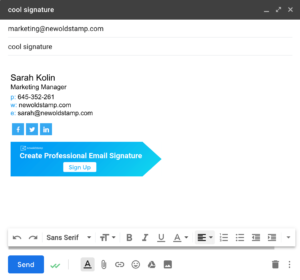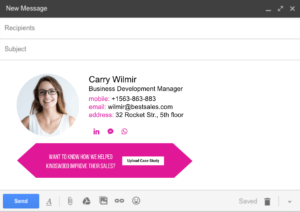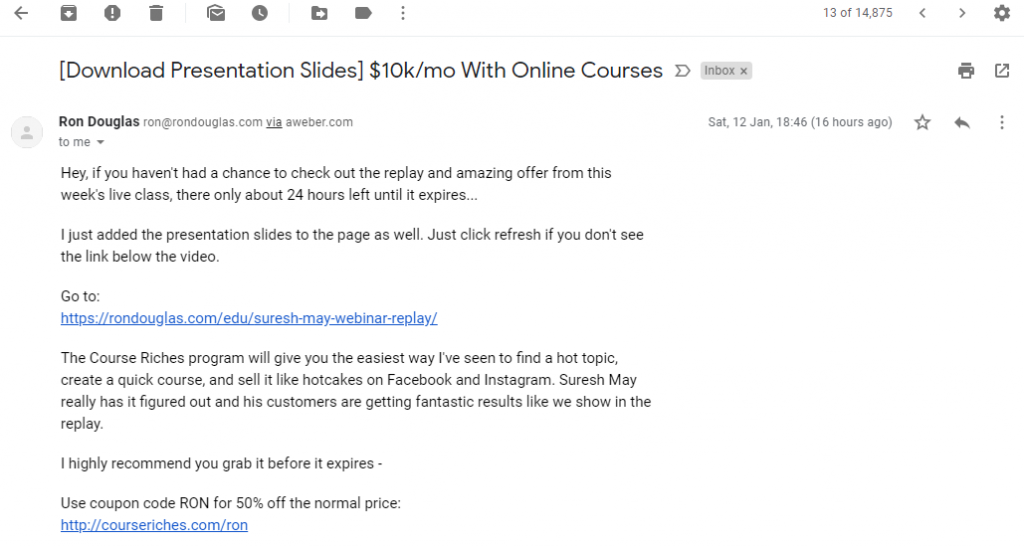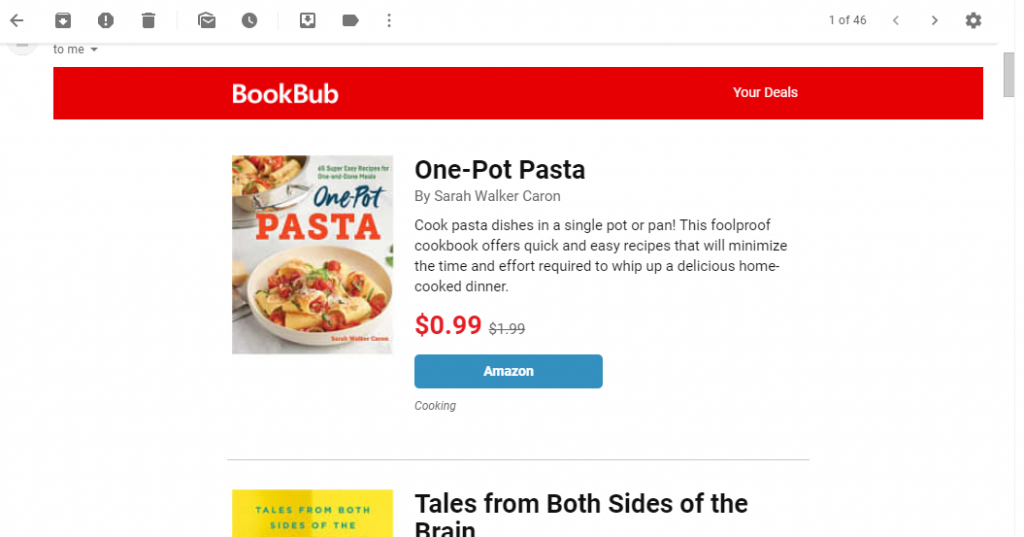Over the years, digital marketing has gone through many different cycles. Every few months, we hear about a new tactic that we have to try.
While we try to make sense of the latest tactics, it’s easy to forget about older and proven methods, such as email marketing. This is a real shame. Email marketing may not be the latest technique, but it is a tried and true way to boost sales.
In this post, we will take a closer look at email marketing and why it is more relevant than ever. We’ll then give you 15 simple but powerful marketing hacks to try for yourself.
Why Email Marketing is More Relevant Than Ever
According to Statista, in 2017, there were 3.82 billion email users. This figure is set to increase to 4.3 billion by 2022. Let’s put that into perspective. Out of the 7.7 billion people in the world, more than 3.82 billion currently use email.

In other words, close to half of the global population currently uses email. Or, put another way, one out of two people use email. So, while email may not seem the sexiest option, it does have a lot of reaches. Emails allow you to get a longer message across quickly and effectively to a wide range of people.
There are countless other statistics that we could quote, but we’re sure that you’re more interested in the hacks. So we’ll get to those in a second!
1. The Subject Line
Your subject line is what is going to get the receiver’s attention. It’s what will make the person decide whether or not to open the email.
Do consider the following when creating a subject line:
- Keep it short – you have 50 characters at most, so make them count.
- Consider using words that get readers’ attention, such as “Alert.”
- Forget spammy phrases like “Sale,” “Best Deal,” and so on. Very few people want to open an email if they know it’s spammy.
- Do consider using the person’s name in the subject line. It could mean more work but can create an impact. There is nothing more eye-catching to someone than their name.
- Make sure that the subject line does match the content. Consider the following example. There was a message with the subject line “Russian pole dancer.” Needless to say, a lot of people opened the email and saw a kitty on a pole. Cute, but a perfect example of how not to bait your clients. A good example would be something like, “Hey Paul, are you ready to look hot this summer?”
- Always use personalized subject lines. Personalized subject lines are believed to bring 50% higher open rates and that’s a percentage you can’t afford to miss out on!
2. Preheader Text
If you have a great subject line, you don’t need a preheader text, right? Wrong. The preheader is the section of the email that the client will see when scrolling through her messages.
This is a golden opportunity to get her even more interested in opening the email. So:
- Take the time to draft it carefully;
- Never leave it blank;
- Don’t repeat the subject line.
A good example would be, “Become a trendsetter with the hottest summer trends.”
3. The Sender Name
We live in a society that is becoming increasingly distrusting, especially when it comes to emails. It’s not surprising, considering the number of fraudsters out there. As a result, we tend to scan the email address of the sender.
Make sure that your address looks legit. That means paying for a dedicated business address instead of just using a free online email address. See for yourself which looks better:
[email protected], [email protected], or [email protected].
Which of these would you think of as legit?
4. Segmentation

Source: 99 Firms
If there is only one takeaway you get from this post, this should be it. You need to segment the email list into groups before you even start writing messages. For example, you could group clients based on age, sex, marital status, and so on.
Choose something that makes sense for you, and then create a massage tailored to that particular group. That way, clients don’t receive many irrelevant emails that they’re not remotely interested in. Moreover, to ensure that your targeted messages reach the email recipient’s inboxes, consider using the SPF record checker and following other email security steps as well․
5. Personalization
Remember in the old days how you used to receive junk mail addressed to “The Occupant.” How many of those envelopes did you open? “Dear subscriber” or any other form of generic greeting is today’s equivalent of “The occupant” and a sure way to get your emails ignored.
Do use the client’s name, and also use your company name in the email. Then, go a step further and choose offers that will be particularly interesting for your reader. Forget generic, one-size-fits-all emails for good.
6. Automation and Triggering
It is extremely simple to program your system to send an email when a trigger event occurs automatically. Choxi did this in response to abandoned carts and improved sales by $3 million. An abandoned cart is a great marketing opportunity.
The client is interested enough in your product to put it in her cart; she needs that extra bit of motivation to complete the purchase.
7. Call to Action
How many of your email campaigns have a great call to action? Is it obvious what the client needs to do? Have a look at the two options below:
![]()
Which one is clearer? With the one on the right, it is obviously a button to press. People understand that they must click the button if they want to buy. The one on the left is trickier. It doesn’t really say “Click me,” does it? Don’t forget to use the marketing power of your email signature. Include CTA buttons and interactive banners in your sign-off to engage people to take action. Email signature generators like Newoldstamp can help you to automate the process.


8. Images
Images in emails could be tricky. First, you have to make sure that they’re big enough to be clear but not too big, or they’ll take forever to load. Still, it’s important to get this right – the right images could make the email interesting and be a good marketing tool.
Stick to a maximum of three images and optimize them so that they are a smaller file size. You can do this by making them smaller and saving them on a medium-quality setting. The changes won’t be noticeable, and you’ll save loads of space.
9. Video
Videos are an extremely useful marketing tool. Implix found that including a video increased its CTR by 96%. It’s not as simple as cranking out a video and sending it to all your subscribers, though.
You should ensure that you use a static image that links to the video rather than embedding it in the message. Add a play button, and the subscriber will go straight to the video.
It’s important to be mindful of your readers here. Having the video run as soon as the email opens is a mistake because the person’s data is being used. She won’t appreciate it if she’s on a metered connection.
Let her know in the subject line that it is a video, and give her the chance to decide when she wants to watch it.
10. Fear of Missing Out
None of us like to feel that we are missing out on something. Use this to your advantage by creating a sense of urgency in the subject line. You could, for example, put in something like, “For today only,” or “Two days to go.”
Make people feel as though they’ll be missing out if they don’t act immediately.
11. Timing
Nothing can tank your email campaign faster than sending it out at the least convenient time for your subscriber. Unfortunately, if it’s sent during the rush to get kids ready for school, or as people rush to get through their work before home time, your client will likely ignore it.
Yes, she could get back to it later, but how likely is it that she’ll remember or even bother? Find out when your subscribers are most likely to be receptive to your emails. Then experiment. Send the emails out at different times of the day and different days of the week.
Check which slot has the most opened emails and stick to that when sending out future campaigns.
12. Mobile Responsive
This is something of a no-brainer, but you’d be amazed at how many companies neglect mobile responsiveness when it comes to emails. Mobile optimization is relatively simple – you want to make sure that the email is small to load as fast as possible.
You also want to make sure that the font and pictures display on the smallest mobile screen as they would on a desktop.
13. The Content
Want to know what the best way to boost conversions for your email campaigns is? Making sure that your content is outstanding. It should be well-written and entertaining. Keep the language simple and use short sentences and paragraphs.
Ideally, you should use between 50 and 150 words – keep it short, sweet, and to the point.
Do consider using dynamic content in the body of the email. You could, for example, have a box of text appear on the screen if someone hovers over a word. This opens the way to give further information without cluttering the page.
14. Formatting
Do you use HTML formatting, or do you use plain text? Plain text emails perform better because they will display on any device. In addition, if your target audience has limited access to the internet, plain text is preferable because the messages won’t take long to load.
This is what a plain text email will look like:

So do think about adding an image or two, but steer clear of HTML otherwise. Want to see the difference? Here’s an email using HTML. As you can see, it looks more interesting. At the same time, though, it is a lot bigger and so will take more time to download

15. Use the Right Software
Using CRM software when you’re running an email campaign allows you to set up the emails and monitor their performance. For example, you’ll be able to see who opened emails when they were opened and much other useful information besides.
These tools will help to effectively determine which campaigns were a success and which were washouts.
Conclusion
That was a lot of information, wasn’t it? However, we’ve established that email marketing is still a handy tool if the campaign is run correctly. We have gone through the 15 hacks to help you take your email campaigns from drab to fab.
It takes some effort, but that effort is well worth making.
